
USS Abercrombie (DE-343) was a John C. Butler-class destroyer escort in the service of the United States Navy from 1944 to 1946. She was finally sunk as a target in 1968.
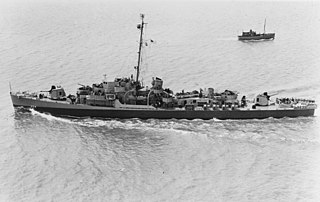
USS Rudderow (DE-224) was the lead ship of her class of destroyer escorts, in service with the United States Navy from 1944 to 1947. After spending decades in reserve, she was sold for scrap in 1970.

USS Bell (DD-587) was a Fletcher-class destroyer of the United States Navy, the second Navy ship named for Rear Admiral Henry H. Bell (1808–1868).

USS Dufilho (DE-423), was a John C. Butler-class destroyer escort.
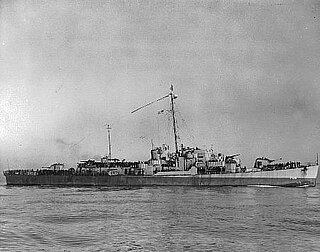
USS Holt (DE-706) was a Rudderow-class destroyer escort of the United States Navy. She was named after William Mack Holt.

USS Walton (DE-361) was a John C. Butler-class destroyer escort in the United States Navy. It was named after Merrit Cecil Walton, a Marine Corps platoon sergeant with the U.S. 1st Marine Division, who died on Gavutu during the Battle of Guadalcanal and was posthumously awarded the Navy Cross for "extraordinary heroism".

USS Ira Jeffery (DE-63/APD-44), a Buckley-class destroyer escort of the United States Navy, was named in honor of Ensign Ira Weil Jeffery (1918–1941) who was killed in action during the Japanese attack on the Hawaiian Islands while serving aboard the battleship California.

USS Barr (DE-576/APD-39), originally a Buckley-class destroyer escort, and later a Charles Lawrence-class fast transport of the United States Navy named for Pvt. Woodrow Wilson Barr of Keyser, West Virginia.
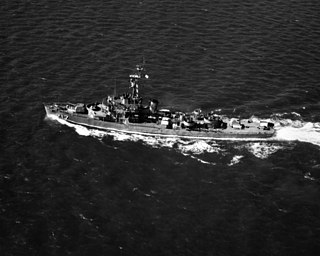
USS Coolbaugh (DE-217) was a Buckley-class destroyer escort in service with the United States Navy from 1943 to 1960. She was scrapped in 1973.

USS Alexander J. Luke (DE/DER-577), a Buckley-class destroyer escort of the United States Navy, was named in honor of Sergeant Alexander J. Luke (1916–1942), who was killed in action during the attack on Tulagi on 6 August 1942. He was posthumously awarded the Silver Star.

USS Robert I. Paine (DE/DER-578), a Buckley-class destroyer escort of the United States Navy, was named in honor of Marine Corps Private Robert I. Paine (1923-1942), who was killed in action during the attack on Tulagi on 7 August 1942. He was posthumously awarded the Silver Star.

USS Oberrender (DE-344) was a John C. Butler–class destroyer escort built for the United States Navy during World War II. She was named for Lieutenant Commander Thomas Olin Oberrender Jr., the engineering officer of the light cruiser USS Juneau, who was killed when that ship was torpedoed and sunk during the Naval Battle of Guadalcanal in 1942.
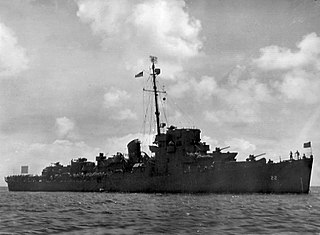
USS Wileman (DE-22) was an Evarts-class destroyer escort constructed for the United States Navy during World War II. It was promptly sent off into the Pacific Ocean to protect convoys and other ships from Japanese submarines and fighter aircraft. At the end of the war, she returned to the United States proudly displaying four battle stars.
USS Johnnie Hutchins (DE-360) was a John C. Butler-class destroyer escort acquired by the U.S. Navy during World War II. The primary purpose of the destroyer escort was to escort and protect ships in convoy, in addition to other tasks as assigned, such as patrol or radar picket. She served in the Pacific Ocean, and, post-war, she returned home with a Navy Unit Commendation awarded to her for her battle with Japanese midget submarines on 9 August 1945.

USS Richard S. Bull (DE-402) was a John C. Butler-class destroyer escort in service with the United States Navy from 1944 to 1946. She was finally sunk as a target in 1969.

USS Loeser was a Buckley-class destroyer escort of the United States Navy, named in honor of Lieutenant Commander Arthur E. Loeser (1903–1942).

USS Ringness (APD-100) was a Crosley-class high speed transport that served in the United States Navy from 1944 to 1946. After spending 29 years in reserve, she was sold for scrapping in 1975.
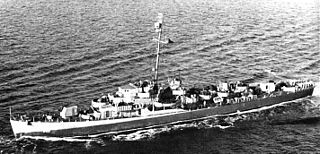
USS Leslie L. B. Knox (DE-580) was a Rudderow-class destroyer escort in service with the United States Navy from 1944 to 1946. She was scrapped in 1973.

USS George A. Johnson (DE-583) was a Rudderow-class destroyer escort serving with the United States Navy from 1944 to 1946. From 1946 to 1957, she was used as a Navy Reserve training ship. She was scrapped in 1966.

USS Tinsman (DE-589) was a Rudderow-class destroyer escort in service with the United States Navy from 1944 to 1946. She was sold for scrapping in 1973.



















